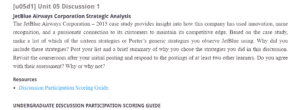JetBlue Airways Corporation Strategic Analysis
JetBlue is one of the leading low-cost carriers in the United States, with over 90 destinations. One main factor that makes this airline stand out is its affordability and passionate connection with its customers. However, JetBlue’s efforts do not excuse the company from the impacts of the highly competitive airline industry in the United States. Thus, the company has had to implement several strategies to maintain a competitive edge.
Would you like an unpublished version of “JetBlue Airways Corporation Strategic Analysis essay”? Contact us
One of the main strategies the company has applied is cost leadership. According to Porter, cost leadership is one of the four generic strategies (Huggins & Izushi, 2011). This strategy involves setting prices that will be considered more competitive. Companies that often use cost leadership strategies charge lower fees than the rest of the businesses in the industry. Therefore, customers seek their services to save their costs. JetBlue has been profitable in an industry dominated by large airlines because of its cost leadership.
Another strategy that this company has applied is concentric diversification. Concentric diversification is diversifying a business’s products by introducing new but related products to the market (David & David, 2017). JetBlue has been introducing ancillary amenities to add to its revenue from passenger fares. The company’s revenue from ancillary products increased by 11% in 2014 to $745 million (David & David, 2017). This diversification has been a good strategy for growing revenue streams, thus, giving the company more money to invest in the development of the company. The ancillary services also help to improve customers’ experiences.
Similar Post: Create a Budget and Financial Plan for a Vacation Trip
References
David, F. R., & David, F. R. (2017). Strategic management: A competitive advantage approach, concepts, and cases. Pearson.
Huggins, R., & Izushi, H. (Eds.). (2011). Competition, competitive advantage, and clusters: The ideas of Michael Porter. Oxford University Press
ORDER A PLAGIARISM-FREE PAPER HERE
We’ll write everything from scratch
Question 
[u05d1] Unit 05 Discussion 1
JetBlue Airways Corporation Strategic Analysis
The JetBlue Airways Corporation – 2015 case study provides insight into how this company has used innovation, name recognition, and a passionate connection to its customers to maintain its competitive edge.

JetBlue Airways Corporation Strategic Analysis
Based on the case study, list which of the sixteen strategies or Porter’s generic strategies you observe JetBlue using. Why did you include these strategies? Post your list and a summary of why you chose the design you did in this discussion. Revisit the courtroom after your initial posting and respond to the postings of at least two other learners. Do you agree with their assessment? Why or why not?
Resources
UNDERGRADUATE DISCUSSION PARTICIPATION SCORING GUIDE
- Due Date: Weekly
Percentage of Course Grade: 30%.
| UNDERGRADUATE DISCUSSION PARTICIPATION GRADING RUBRIC | ||||
| Criteria | Non-performance | Basic | Proficient | Distinguished |
| Apply relevant course concepts, theories, or materials correctly. 33% |
Does not explain relevant course concepts, theories, or materials. | Explains relevant course concepts, theories, or materials. | Applies relevant course concepts, theories, or materials correctly. | Use examples or supporting evidence to analyze course concepts, theories, or materials correctly. |
| Collaborate with fellow learners, relating the discussion to relevant course concepts. 33% |
Does not collaborate with fellow learners. | Collaborates with fellow learners without relating the discussion to the relevant course concepts. | Collaborates with fellow learners, relating the discussion to relevant course concepts. | Collaborates with fellow learners, relating the discussion to relevant course concepts and extending the dialogue. |
| Apply relevant professional, personal, or other real-world experiences. 34% |
Does not contribute professional, personal, or other real-world experiences. | Contributes professional, personal, or other real-world experiences, but contributions lack relevance. | Applies relevant professional, personal, or other real-world experiences. | Applies relevant professional, personal, or real-world experiences to extend the dialogue. |